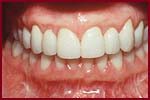One extremely esthetic type of tooth replacement is the Encore® bridge. This restoration can be used if the teeth on either side of the missing tooth do not have crowns or other large restorations. Besides being very esthetic, it does not require the dentist to grind down the adjacent teeth. The principal disadvantage is that it is not quite as solid as a conventional porcelain-to-metal dental bridge and there is a slight risk of it breaking or coming loose. It also requires a high degree of skill to place properly. Do not ask your general family dentist to place one of these types of tooth replacement. To find an expert cosmetic dentist, please visit our cosmetic dentist referral page.

A diagram of the framework of an Encore® bridge
In placing an Encore® bridge, the cosmetic dentist cuts a space similar to what he or she would do for a filling in each of the two adjacent teeth. Then a framework of tough, fiber-reinforced tooth-colored resin is bonded into those filling spaces, and this framework spans the space of the missing tooth. After bonding in the framework, a porcelain veneer is bonded onto the front of the framework to simulate a natural tooth. The result is extremely natural, and it is difficult to tell from the front that anything artificial is present in the mouth.
Below is an example of an Encore® bridge case. This work was done by Dr. Gary Radz, a mynewsmile.com network cosmetic dentist from Denver, Colorado. Click here for more information about Dr. Radz.


Before

After the placement of two encore bridges. You can hardly tell they’re not real.
The concept of the Encore® bridge is a variation of the Maryland bridge, which also bonds to the adjacent teeth, but uses a metal framework. The metal, which is placed on the back of the adjacent teeth, will darken those teeth slightly, and thus there is a problem with the esthetics of this type of bridge.
2016 Update on the Encore Bridge
There is now an excellent aesthetic alternative to the Maryland Bridge, stronger and a little easier to place than the Encore Bridge—it is the zirconia Maryland Bridge. Click the link to see my blog post on this, with a photograph.
You may also be interested to read about the ovate pontic technique, which makes it appear that the false tooth is growing out of the gum.
This information is brought to you by www.mynewsmile.com, your popular and authoritative source for cosmetic dentistry information and referrals.
This content was written by Dr. David Hall



